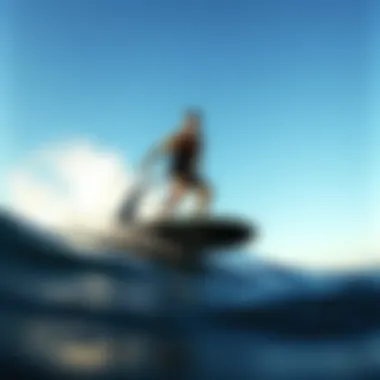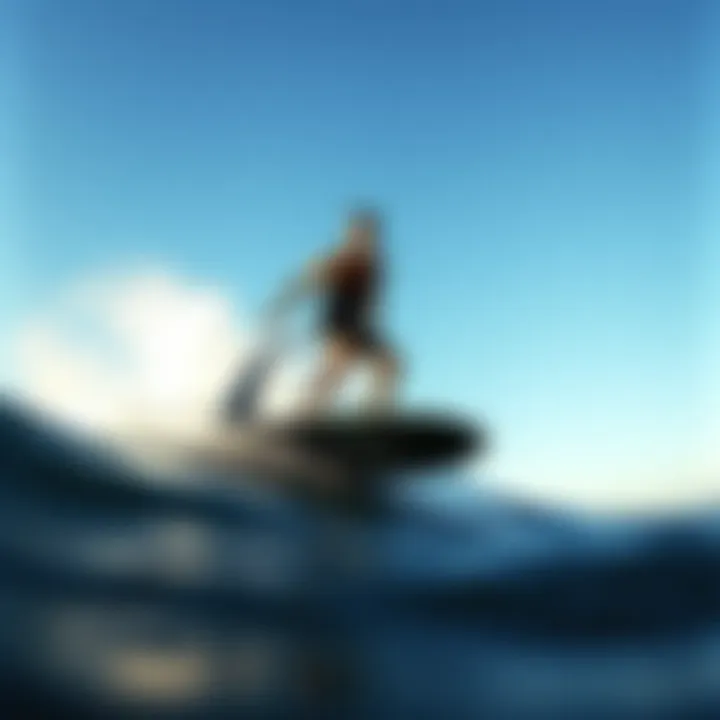Foil Surfing Boards: Design, Dynamics, and Technique


Intro
In the realm of water sports, foil surfing has emerged, carving its niche in the hearts of kiteboarders and surfing aficionados alike. The allure lies not only in the thrill of gliding above the water but also in the intricate dynamics involved in mastering the sport. As enthusiasts seek to elevate their riding experience, understanding foil surfing boards becomes imperative. These boards represent the intersection of innovation and tradition, marrying cutting-edge technology with time-honored riding techniques.
Recognizing the pivotal role of design and functionality, we will navigate through the complexities of foil surfboards, unraveling the physics that make them soar. The world of foil surfing boards is vast, encompassing various shapes, sizes, and materials, each tailored to specific conditions and riding styles. For those driven by a passion for the waves and a thirst for knowledge, this guide will provide crucial insights into selecting the right equipment, honing techniques, and ensuring safety while riding.
As we delve deeper, we will explore how maintenance affects performance and longevity, while also assessing the impact of recent technological advancements on foil design. Whether you’re a novice looking to catch your first wave or a seasoned pro aiming to perfect tricks, understanding your equipment and technique can reshape your riding experience altogether. Join us as we embark on this detailed journey through the world of foil surfing boards.
Understanding Foil Surfing
Foil surfing has taken the watersports world by storm, opening new doors for enthusiasts seeking thrill and speed. At its core, understanding foil surfing is about grasping the dynamics of how the board interacts with the water. This knowledge not only enhances performance but also enriches the overall riding experience. By delving into the mechanics of foil surfing, one can appreciate the intricacies of design and performance that set it apart from traditional surfing and kiteboarding.
What is Foil Surfing?
Foil surfing involves using a specialized board equipped with an underwater wing—called a foil—that lifts the surfer above the water’s surface. As the surfer gains speed, the foil creates lift, allowing the board to glide effortlessly over the waves. This unique mechanism enables the rider to experience a sensation akin to flying, transforming the way one interacts with the ocean. It’s all about harnessing the power of hydrodynamics to achieve movement that feels almost magical.
The Physics Behind Foil Surfing
A solid grasp of physics is essential for anyone looking to elevate their foil surfing experience. The principles governing foil surfing encompass various forces and dynamics that can either make or break a ride. Understanding these foundational concepts helps surfers navigate the complexities of balance, speed, and stability. Here’s a closer look into the three main components:
Hydrodynamics Explained
Hydrodynamics, the study of fluids in motion, is key to foil surfing. Essentially, it deals with how the water moves around the foil and board. One important characteristic of hydrodynamics is the concept of flow separation. When a foil is angled correctly, water flows smoothly around it, reducing drag and increasing lift. This is crucial for a successful ride, as too much drag can lead to instability and a loss in speed.
A unique feature of where hydrodynamics shines through is in the shapes of the foils. Different designs can impact performance significantly, affecting how easily a surfer can lift from the water. Knowledge of hydrodynamics not only aids in selecting the right gear but also plays a role in mastering riding techniques, leading to a more enjoyable surfing experience.
Lift and Drag Forces
In the context of foil surfing, lift and drag are two interrelated forces that surfers must continually balance. Lift is the upward force generated as water flows over the foil, while drag is the resistance that opposes forward movement. An essential characteristic of both forces is their dependence on the angle of attack of the foil. Finding the right balance is key; too much lift can make control difficult, while too little can cause the board to sink.
This aspect of lift and drag is beneficial because understanding how to manipulate these forces can enhance performance. Surfers can learn to position themselves on the board to optimize their ride, tailoring their movements to create optimal lift without generating excess drag. This knowledge often separates the proficient from the novice.
Balance and Stability
Balance and stability are critical in foil surfing, especially since the ride involves being positioned above the water rather than on it. The main attraction of foil surfing lies in the smooth glide, but achieving this requires a keen understanding of body positioning and weight distribution. The surfer must remain centered to prevent wobbling or, worse, falling into the water.
The core principle of balance entails adjusting one’s posture while riding—leaning forward slightly tends to increase lift, while leaning back can put the foil too deep into the water. A unique feature of balance dynamics in foil surfing is how body movements can create a ‘pendulum effect’ that affects flow and stability, thus enabling sharper turns and quicker maneuvers.
Components of a Foil Surfing Board
Understanding the components of a foil surfing board is crucial for any kiteboard enthusiast. Each part, from the board structure to the foil design, contributes to the overall performance and experience on the water. Choosing the right components can enhance your ability to catch waves and maintain stability, ensuring a smoother ride. In this section, we will dissect the main elements of a foil surfing board, emphasizing their specific characteristics, benefits, and other considerations vital for making informed decisions.
The Board Structure
Materials Used
The materials used in constructing a foil surfing board are fundamental to its performance. Most boards are made from materials like fiberglass, carbon fiber, and foam. For instance, carbon fiber offers excellent strength-to-weight ratio which translates into a lightweight board that does not compromise on durability. Fiberglass, although heavier, provides flexibility and resilience, making it a popular choice for newcomers who might want a more forgiving ride.
One interesting characteristic of foam cores is their buoyancy. This unique feature helps the board float well, allowing users to paddle and position themselves easily, especially in choppy waters. However, foam can be susceptible to waterlogging if not properly sealed, which is a downside to consider. Overall, selecting the right material for your board is less about personal preference and more about aligning with riding conditions and skill levels.
Design Considerations
When assessing design considerations, the shape and dimensions of the board are paramount. Wider boards typically provide increased stability, which is great for beginners learning to balance while riding. Conversely, narrower boards are more agile and suited for advanced riders looking to perform sharp turns and tricks.
Designing with features like rocker (the upward curve of the board’s nose and tail) can greatly affect how the board interacts with water. A pronounced rocker helps in reducing drag while paddling in waves—a key characteristic for any board aiming for performance in surf conditions. However, too much rocker could hinder speed on flat waters, creating a tradeoff that needs careful thought.
Foils and Fuselages
Different Types of Foils
Foils can fundamentally change the riding experience. There are varying types of foils designed for different water conditions and rider preferences. For example, high-aspect foils, known for their efficiency, allow for great speed with less drag, making them ideal for flat waters or longer distances. On the other hand, low-aspect foils provide better lift at lower speeds, beneficial for those seeking to ride smaller waves or for beginners.
A significant feature of these foils is their surface area. A larger wing area increases lift, which is perfect for lighter riders but might require a more skilled rider to manage efficiently. Different types still maintain their pros and cons, thus understanding your riding style will help guide your choice.
Fuselage Length and Stability
Fuselage length is another critical factor that dictates the overall stability of a foil setup. A longer fuselage tends to provide better stability during rides, making it easier to maintain balance, especially for new surfers. Conversely, shorter fuselages can increase maneuverability and responsiveness, allowing advanced kiteboarders to perform intricate tricks and sharp turns.
The inherent trade-off between stability and agility defines much of what riders may prefer. With greater responsive handling, a rider may feel more in control, but it can come at the expense of overall stability. Thus, selecting a fuselage that aligns well with your skill level and riding environment is paramount for maximizing enjoyment.
"Each component of a foil surfing board offers unique advantages and challenges—understanding these can help craft a customized surfing experience."
In order to select the optimal foil surfing gear, understanding these various elements is essential. With the right board structure and fuselage setup, kiteboarders can optimize performance, enhance control, and ultimately enjoy a better ride on the water.


Selecting the Right Foil Surfing Board
Choosing the right foil surfing board isn't just a casual decision; it’s pivotal to how well you’ll glide over the waves. A few factors can make or break the experience as well as your progress in mastering this sport. Getting this selection right could be the difference between gliding effortlessly through the water or struggling to even catch a wave. Let's unpack the core considerations you should have in mind.
Factors to Consider
Skill Level
Your skill level dictates, in many ways, the type of board that suits you best. Beginners often benefit from boards that offer more stability and easier handling. A wider board with a larger foil can facilitate balance, making it less daunting to learn how to ride. Think of it like learning to ride a bike—having training wheels gives you that extra support until you build enough confidence.
The unique characteristic of lower skill levels is the need for reliability. A forgiving board can help you enjoy the sport without the constant fear of wiping out. However, some might argue that starting on a smaller, performance-oriented board can accelerate skill improvement. This means higher effort initially but potentially faster learning. It’s a balancing act that boils down to your comfort and willingness to face challenges.
Weight Considerations
This one goes a bit deeper than just picking a board to stand on. Your weight significantly impacts the performance of the board and foil. He's the catch: heavier riders may want a larger board with more volume to get the lift they need and remain buoyed when attempting maneuvers. Lighter riders, on the other hand, can afford to use smaller boards that are more agile and responsive.
A unique feature of weight considerations is understanding that it also affects how the foil interacts with water. Miscalculating your weight might mean struggling with maneuverability, which can be quite frustrating. Additionally, being aware of your weight can guide you as to the size of foil you should opt for.
Riding Conditions
Unpredictable riding conditions can put a wrench in the works if you're not prepared. Understanding where and when you plan to ride directly affects your selection process. Some boards, for instance, perform better in choppy waters while others excel in flat conditions.
The biggest takeaway here is that various shapes and volumes react differently depending on water conditions. Picking a board that meshes well with expected conditions means you'll have a smoother ride, no doubt. If you live near a surf spot known for a particular type of wind and wave, matching your board selection to that environment is perhaps one of the smartest moves you can make.
Top Brands and Models
When stepping into the scene of foil surfing, knowing who the key players are can save you a lot of head-scratching. Each brand typically has models that cater to different styles and skill levels, making comparisons essential.
Performance Comparisons
Performance comparisons among brands isn’t just an exercise in brand loyalty; it offers critical data on how each board delivers under real conditions. Popular brands like Duotone, Naish, or Slingshot have various models that range from beginner-friendly to high performance.
Examining performance can involve looking at speed, stability, and even the type of tricks that are easier to execute on a particular board. This gives you a clearer idea of what suits your riding style or where your potential might lie. Understanding those attributes can lead to better performance and, ultimately, more enjoyment.
Price Range Analysis
Last but not least, let’s dive into the price ranges of foil boards. Prices can swing widely based on brand, materials, and technology. It may tempt you into thinking that a more expensive board guarantees better performance, but that's not always the case.
Here’s the rub: setting a budget is essential before exploring options. It’s a known fact that you can find great boards for various budgets, but it makes sense to figure out how much you’re willing to spend first. Always balance price with performance features and make sure you get the best bang for your buck.
In closing, selecting the right foil surfing board involves more than picking something shiny off the shelf. It’s about matching your individual needs to what’s available in today’s market while considering various factors that influence performance. It might feel daunting at first, but with the right approach, you’ll find the board that leads you to conflicts with oceans waves—or rather, gives you the thrill of mastering them.
Techniques and Practices for Effective Foil Surfing
Foil surfing is not just about having the right gear; it's equally about mastering the techniques that allow you to make the most of that gear. Specific skills can transform a novice into a proficient foil surfer. The techniques employed in foil surfing include basic maneuvers to get started, as well as advanced practices that extend your capabilities on the water. Each technique offers benefits and challenges that contribute to the overall mastery of the sport.
Basic Techniques
Starting and Stopping
Starting and stopping are fundamental skills for anyone looking to unleash the full potential of foil surfing. Getting off to a clean start is crucial. To do so, you must ensure that you are balanced and positioned correctly on the board. The primary characteristic of a successful start is the distribution of your weight; leaning forward slightly helps in gaining instant lift off the water. As for stopping, it entails shifting your weight back gradually to reduce speed before you come to a halt.
Advantages:
- Control: Mastery of these basic moves fosters greater control over your speed and direction.
- Safety: Knowing how to stop can help avoid collisions or falls, making it safer for you and those around you.
But beware, too much weight shift can lead to a tumble. So, it's about finding that sweet spot. A good starting technique makes the experience more enjoyable, while a poor one can lead to frustration or even injury.
Turning and Carving
Turning is another critical technique that allows surfers to navigate through waves. Carving refers to the art of making smooth, curved turns while maintaining speed and form. Proper turning technique involves using your body to lean into the direction you want to go, coupled with a strong rail engagement to help carve the board in that direction.
Benefits:
- Fluidity: The ability to carve makes your surfing more fluid and dynamic, enhancing that feeling of grace.
- Control: Developing good turning techniques also supports better control when interacting with waves and other surfers, reducing the risk of accidents.
While turning is essential for maneuverability, carving requires practice to perfect, particularly when dealing with changing water conditions. Therefore, honing this skill is vital to becoming a seasoned foil surfer.
Advanced Techniques
Jumping and Tricks
Once you have mastered the basics, jumping and performing tricks can set you apart from the crowd. The key to jumping lies in timing and the balance between your weight distribution and board speed. A well-timed jump allows you to leave the water and catch air, which adds an exhilarating element to your foil surfing. Tricks such as spins or grabs come into play once you've conquered jumping.
Advantages of Jumping:


- Style Points: Tricks can elevate your performance on the water, impressing fellow surfers and making your outings more exciting.
- Skill Showcase: Jumping and trick techniques serve as milestones that show your progression and confidence in foil surfing.
However, these advanced moves come with risks and can lead to falls if not executed correctly. Practicing on safer waters is advisable before transitioning to more complex maneuvers.
Maintaining Speed and Control
In foil surfing, maintaining speed while controlling the board is an essential advanced technique. It involves fine-tuning your body position and weight distribution while staying aware of the conditions around you. Proper pumping techniques can help you stay afloat and maintain momentum, even when waves aren’t in your favor.
Key Features:
- Efficiency: Being able to manage your speed effectively can lead to longer rides and the ability to navigate larger swells.
- Experimentation: Mastering this technique allows you to experiment with various situations, confidence in trying out new locations or waves.
But maintaining speed while controlling your board requires practice, as inconsistent practices can lead to unstable rides.
In summary, mastering these fundamental and advanced techniques can significantly enhance your foil surfing experience. Each technique contributes to making your ride not just about having fun, but about maximizing your potential in this thrilling sport.
Safety Considerations in Foil Surfing
Foil surfing, while exhilarating and innovative, can pose a range of hazards if safety precautions are overlooked. Selecting the right gear, being aware of your surroundings, and understanding the water conditions are all crucial elements that contribute to a safe experience. This is particularly important as the dynamics of surfing with a foil board introduce unique challenges that can lead to injuries if not approached thoughtfully. Prioritizing safety not only enhances your own experience but also ensures the enjoyment of those around you on the water.
Essential Safety Gear
Helmets and Impact Vests
A helmet may seem like an obvious choice when considering safety in any sport, and foil surfing is no exception. Helmets designed specifically for this sport are lightweight yet durable, providing essential protection while allowing for relative comfort during long rides. Using a helmet minimizes the risk of head injuries from falls or collisions, which can occur unexpectedly, especially for novice riders learning the ropes.
Impact vests play a similar role in providing protection from potential impacts with the board or the water surface. They have been made with buoyancy in mind, which can help prevent a complete submersion in case of a wipeout. These vests are typically designed to support the chest and torso, giving an extra layer of protection where it counts. However, their bulk can be a disadvantage, potentially restricting movement.
Key characteristics of helmets and impact vests are:
- Lightweight construction for ease of wear
- Enhanced buoyancy to support the body in water
- Impact resistance to cushion against falls
On the flip side, one must consider that the added protection might feel cumbersome for those who prefer unrestricted movement. Nevertheless, the benefits far outweigh any inconvenience, making helmets and impact vests a must-have in any foil surfer's gear.
Leashes and Quick Releases
Leashes are crucial for any surfer, and they take on added significance in foil surfing. They ensure that your board stays close, reducing the chances of a runaway board that could potentially cause injury to others. Many modern leashes come with a quick release mechanism. This feature is invaluable. In situations where you find yourself struggling or where the board has become a hazard, a quick-release option allows you to free yourself from tangles immediately.
A leash with a quick release provides peace of mind. It allows the rider to focus on riding rather than worrying about how to get untangled in an emergency. However, one possible disadvantage of leashes is the potential for entanglement during a wipeout, so proper training in usage is essential.
Key characteristics to consider with leashes include:
- Durability, to withstand the harsh conditions
- Length, as having the right length can assist in board control
- Quick release mechanism, for emergency situations
While these safety items may seem like a simple addition to your gear, they truly are foundational. Neglecting the right safety gear increases risks whereas having it can provide confidence on the water.
Understanding the Environment
Assessing Water Conditions
Before hitting the waves, assessing the water conditions is imperative. Factors like wind speed, wave height, currents, and water temperature all affect your foiling experience. Understanding the nuances of the environment can be the difference between a cheerful session and a tumultuous one. For instance, too much wind can make control difficult for beginners, while strong currents could make getting back to shore a daunting task.
When assessing conditions:
- Wind direction and speed significantly impact ride quality
- Wave sizes dictate the type of turns and maneuvers you can execute
- Current strength can affect your stamina and overall timing
In addition, each spot has its own unique characteristics which can change day-to-day. This means that understanding local conditions and consulting forecasts is beneficial.
Awareness of Other Surfers
The waters can get crowded, especially at popular surf spots. Awareness of other surfers is crucial not only for your own safety but also for theirs. Familiarize yourself with the rules of priority in surfing. Also, recognizing the space around you will help prevent collisions, which can be dangerous at high speeds, particularly with a foil board’s elevated profile.
Being aware means scanning your surroundings regularly, observing where others are riding, and ensuring there’s enough distance between you and fellow surfers. The potential downside of not maintaining awareness can lead to injuries, both minor and serious, as you navigate through what can be sometimes chaotic waters.
In summary, safety considerations in foil surfing are multi-faceted. From gearing up appropriately to staying vigilant in a crowded environment, each aspect weaves together to create a safe surfing experience. Ignoring these considerations is putting not only your adventure at risk but also jeopardizing that of others. Taking steps to gear up and pay attention can lead to countless exhilarating rides ahead.
Maintenance and Care for Foil Surfing Boards
Maintaining and caring for foil surfing boards is not just a trivial task; it’s a necessary practice to ensure longevity and maximize your time on the water. Whether you're a seasoned pro or just starting out, a well-maintained board enhances performance and provides an enjoyable experience. In this section, we delve into cleaning routines, storage practices, and troubleshooting to prepare you for adventures on the waves.
Cleaning and Storage
Post-Surfing Cleaning Routines


After a day of thrashing through the waves, tending to your board might seem like a drag, but it’s a critical step to extend its life. Saltwater and sand can do a number on your equipment, leading to corrosion and degradation over time. A typical cleaning routine should involve rinsing off your board with freshwater immediately after your surf session. This helps flush away the abrasive salt that could accumulate and cause wear.
- Key Characteristic: The emphasis on prompt freshwater rinsing. It is a simple yet invaluable practice that keeps your board in top condition.
- Unique Feature: Investing a bit of time in this routine gives you more time on the water in the long run, reducing the need for frequent repairs. However, be cautious not to scrub too harshly, as this can scratch the surface.
Seasonal Storage Practices
When the surfing season winds down or if you’re heading away for a while, proper storage of your gear becomes paramount. Keeping your foil board in a climate-controlled space away from direct sunlight is critical. Excessive heat can warp materials, and prolonged exposure to UV can deteriorate the integrity of the board's surface.
- Key Characteristic: Keeping your board in a cool, dark space helps preserve its condition.
- Unique Feature: Use a board bag for added protection; it cushions against bumps and scrapes while also guarding against dust. Lack of storage care can lead to unforeseen costs down the line, from repairs to replacements.
Troubleshooting Common Issues
Identifying Damage
Being able to spot damage on your foil board promptly is crucial to maintaining its performance. Common issues include dings, delamination, or bends in the foil. Regularly inspect the surface after every session, paying attention to any oddities like water ingress or visible cracks. This practice not only saves time but also ensures you're safe when you hit the water next.
- Key Characteristic: Proactive inspection can prevent small issues from ballooning into expensive repairs.
- Unique Feature: Keeping a journal of inspections and repairs can help you track your board's condition over time, aiding in your maintenance decisions.
Repair or Replace: Making the Decision
Once damage is identified, the next step is to decide whether to repair or replace the board. This decision can hinge on the extent of the damage and the age of the board. If repairs are minor and the board is relatively new, fixing it can be a great choice. On the flip side, a board that has seen years of action might be better off being retired in favor of a new model that could offer improved performance.
- Key Characteristic: Balancing costs between repair and replacement is vital.
- Unique Feature: Consider the emotional investment in your board; sometimes, it’s also about the enjoyment. Whether to repair or replace can turn into a sentimental choice, especially if a board has been a trusty companion on many adventures.
Ultimately, maintaining your foil surfing board is not just about prolonging its lifespan. It’s about enhancing your overall surfing experience, ensuring that when you hit the waves, everything is in peak condition.
For more information on board care techniques, see resources like Britannica and surf enthusiast discussions on Reddit. You can also find helpful tips on specific maintenance products from brands like LiquidForce and Slingshot.
Future Innovations in Foil Surfing Gear
As the world of foil surfing continues to evolve, it becomes vital to pay close attention to the innovations that shape the future of gear in this exhilarating sport. With advancements in technology and material science, the performance, safety, and environmental sustainability of foil surfing gear are all seeing positive changes. These advancements not only enhance the rider's experience but also open doors to new possibilities in performance capabilities. Addressing this topic unveils insights into crucial elements and benefits that make these innovations significant for both amateur and seasoned kiteboarders.
Emerging Technologies
Smart Gear Integration
Smart gear integration is one of the most exciting developments in foil surfing gear. Imagine a world where your foil, board, and even your wetsuit could communicate with one another. The key characteristic of smart gear lies in its ability to collect, analyze, and transmit data back to the surfer in real-time. This kind of integration allows for adjustments based on riding conditions, thus enhancing overall performance on the water.
A unique feature of this technology is the implementation of sensors and GPS modules within the equipment. These sensors can track vital metrics such as speed and altitude, which help in improving technique. While incredibly beneficial, it does come with its downsides, primarily around potential concerns for durability and the necessity for charging or maintaining the gear's electronics. However, the advantage of having actionable information at one’s fingertips, making for more informed surfing decisions, often outweighs these concerns.
Enhanced Materials and Designs
When we talk about enhanced materials and designs in foil surfing, what we are looking at is a leap forward in both performance and durability. As manufacturing techniques advance, new materials like carbon fiber and advanced plastics bring an edge to traditional designs. The main characteristic here is the lightweight nature of these materials, which significantly improves maneuverability and responsiveness on the water.
For instance, boards constructed with these advanced composites don’t just weigh less; they also provide greater strength and resilience against impacts. One unique element to consider is how the design of foils has also evolved, with hydrodynamic profiles becoming more optimized for speed and lift. Despite these advantages, the trade-off may come in terms of cost, as high-end materials often carry a hefty price tag. Nonetheless, the performance benefits they offer often make them a worthy investment for serious riders.
Impact on Performance
Performance Metrics
Performance metrics are essential to understanding how innovations in gear translate to actual riding performance. By focusing on specific data points—such as speed, lift, and stability—surfers can gain a clear perspective on how different designs and materials impact their ride. The key characteristic is that these metrics provide quantifiable criteria for evaluating equipment, allowing for better-informed purchasing decisions.
A unique feature of tracking performance metrics is how they enable riders to set goals and benchmark their development over time. The downside, however, is that an over-reliance on metrics can lead one to become too focused on numbers rather than enjoying the experience on the water. But for many, having these figures provides clarity and direction in refining their skills, adding another layer to the sport for those who thrive on understanding the mechanics behind their performance.
Feedback from Top Athletes
Feedback from top athletes in the foil surfing community proves invaluable in shaping future gear. These riders often test and provide commentary on new innovations, paving the way for improvements in design and functionality. The characterizing factor here is that their insights often reflect the nuanced experiences one may not easily see in general reviews.
One unique aspect of this feedback is how it directs manufacturers towards making alterations based on real-world usage rather than theoretical models. The downside is that what works for a professional athlete might not suit every level of a rider, creating a divide between performance gear and more accessible options for beginners. Still, this feedback loop is critical, as it creates a pathway for growth in both manufacturers and surfers alike, resulting in better performance gear that appeals across various skill levels.
"Innovation in surfing gear is not just about making things lighter or faster. It's about redefining what’s possible on the water, pushing boundaries, and elevating the sport itself."
The End
In wrapping up our exploration of foil surfing boards, it’s paramount to recognize the multifaceted nature of the topic. Foil surfing isn’t merely about catching waves; it’s a synthesis of physics, skill, and technology. Each surfer, be they seasoned or just getting their feet wet, can benefit from understanding the intricate dynamics involved. The readers of this article—kiting enthusiasts, instructors, and aficionados—are reminded of the vast potential that lies in mastering foil surfing through optimal gear selection and technique refinement.
Recap of Key Insights
Reflecting on the preceding sections, several key takeaways emerge:
- Physics of Foil Surfing: Comprehending the principles of hydrodynamics, lift, and drag is critical to improving performance on the water.
- Components Analysis: The role of materials and design in a foil board can greatly influence buoyancy and stability, affecting how a surfer interacts with the ocean.
- Safety and Maintenance: Emphasizing safety gear alongside proper board care ensures both longevity of equipment and well-being of the surfer.
- Emerging Technologies: Innovations within the industry promise to alter the landscape of foil surfing gear, opening doors for enhanced performance in riding conditions.
These insights not only enhance theoretical knowledge but also promote practical applications that surface in real-world scenarios, allowing for informed choices in both gear and technique.
The Future of Foil Surfing
As we look ahead, the evolution of foil surfing holds exciting prospects. Innovations such as smart gear integration aim to elevate user experience, providing data-driven insights into performance and conditions. Enhanced materials, like improved composites, are likely to emerge, offering greater durability and lighter weights. Furthermore, feedback from top athletes will continue to push manufacturers towards crafting boards that allow both novice and expert riders to flourish.
A robust community spirit is a central pillar as well, with platforms like Reddit and Facebook fostering discussions among enthusiasts from every corner of the globe. This exchange of ideas is instrumental in shaping the future of foil surfing, fostering not only skill development but camaraderie among participants.
Ultimately, the horizon of foil surfing appears to be brimming with possibilities yet to be grasped. Whatever direction the winds may take, the journey promises to be as exhilarating as riding the surf itself. In the world of foil surfing, the only limit truly is one’s imagination.







